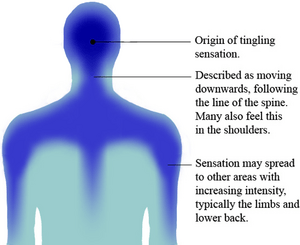Autonomous sensory meridian response facts for kids
Autonomous sensory meridian response (ASMR) is a special tingling feeling. It usually starts on your scalp (the top of your head). Then, it can move down your neck and upper spine. This feeling is like a gentle tingle on your skin. Some people describe it as a "low-grade euphoria", which means a calm and happy feeling. It's a mix of good emotions and that distinct tingling sensation.
ASMR is often triggered by certain sounds or things you see. For example, soft whispers, gentle tapping sounds, or watching someone do a quiet task can cause it. There are many videos on YouTube made to help people experience ASMR. Over 13 million of these videos exist online!
Contents
What is ASMR?
ASMR stands for Autonomous Sensory Meridian Response. It's a unique experience for many people. It's not a medical condition or a disease. Instead, it's a pleasant sensation that some people feel in response to specific triggers. The tingling feeling is a type of paresthesia, which just means a tingling or "pins and needles" sensation on the skin. But unlike an uncomfortable tingle, ASMR is usually very relaxing and enjoyable.
How Does ASMR Feel?
People who experience ASMR often describe it as a wave of relaxation. The tingling starts on the scalp. It then spreads down the back of the neck. It can also move down the upper part of the spine. This feeling is often paired with a sense of calm and well-being. It's like a gentle, pleasant shiver that helps you feel relaxed. Many people use ASMR to help them unwind or even fall asleep.
What Triggers ASMR?
ASMR can be triggered by many different things. These triggers are usually sounds or visual cues. They are often quiet, repetitive, or focused.
Some common sound triggers include:
- Soft whispering or gentle speaking.
- Tapping on various surfaces, like wood or glass.
- Crinkling sounds, such as paper or plastic.
- Brushing sounds, like hair brushing or fabric rubbing.
- Scratching sounds.
Visual triggers can include:
- Watching someone perform a quiet, focused task.
- Seeing gentle, repetitive movements.
- Observing someone drawing or writing.
Sometimes, ASMR can also be triggered by personal attention. This might happen when someone is very attentive to you, like a hairdresser or a doctor.
ASMR Videos and Community
The rise of ASMR videos on YouTube has created a large community. People who make these videos are called "ASMRtists." They create content specifically designed to trigger ASMR in viewers. These videos often feature close-up sounds and gentle visuals. Popular types of ASMR videos include:
- Role-playing scenarios, like a virtual haircut or a doctor's visit.
- "No talking" videos, focusing only on sounds.
- Videos with specific sound triggers, like slime tapping or keyboard typing.
Many people watch these videos for relaxation, stress relief, or to help with sleep. The ASMR community is a place where people share their experiences and favorite triggers.
Images for kids
See also
 In Spanish: ASMR para niños
In Spanish: ASMR para niños




